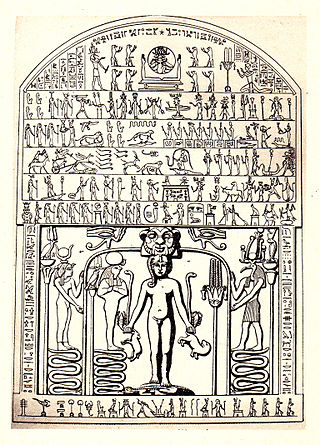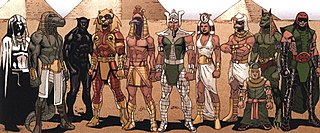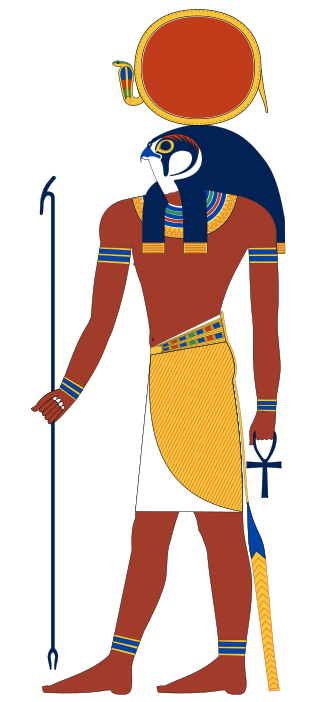
Osiris was the god of fertility, agriculture, the afterlife, the dead, resurrection, life, and vegetation in ancient Egyptian religion. He was classically depicted as a green-skinned deity with a pharaoh's beard, partially mummy-wrapped at the legs, wearing a distinctive atef crown, and holding a symbolic crook and flail. He was one of the first to be associated with the mummy wrap. When his brother Set cut him up into pieces after killing him, Osiris' wife Isis found all the pieces and wrapped his body up, enabling him to return to life. Osiris was widely worshipped until the decline of ancient Egyptian religion during the rise of Christianity in the Roman Empire.

Horus, also known as Hor, in Ancient Egyptian, is one of the most significant ancient Egyptian deities who served many functions, most notably as the god of kingship, healing, protection, the sun, and the sky. He was worshipped from at least the late prehistoric Egypt until the Ptolemaic Kingdom and Roman Egypt. Different forms of Horus are recorded in history, and these are treated as distinct gods by Egyptologists. These various forms may be different manifestations of the same multi-layered deity in which certain attributes or syncretic relationships are emphasized, not necessarily in opposition but complementary to one another, consistent with how the Ancient Egyptians viewed the multiple facets of reality. He was most often depicted as a falcon, most likely a lanner falcon or peregrine falcon, or as a man with a falcon head.

The Osiris myth is the most elaborate and influential story in ancient Egyptian mythology. It concerns the murder of the god Osiris, a primeval king of Egypt, and its consequences. Osiris's murderer, his brother Set, usurps his throne. Meanwhile, Osiris's wife Isis restores her husband's body, allowing him to posthumously conceive their son, Horus. The remainder of the story focuses on Horus, the product of the union of Isis and Osiris, who is at first a vulnerable child protected by his mother and then becomes Set's rival for the throne. Their often violent conflict ends with Horus's triumph, which restores maat to Egypt after Set's unrighteous reign and completes the process of Osiris's resurrection.

Set is a god of deserts, storms, disorder, violence, and foreigners in ancient Egyptian religion. In Ancient Greek, the god's name is given as Sēth. Set had a positive role where he accompanies Ra on his barque to repel Apep (Apophis), the serpent of Chaos. Set had a vital role as a reconciled combatant. He was lord of the Red Land (desert), where he was the balance to Horus' role as lord of the Black Land.

Thoth is an ancient Egyptian deity. In art, he was often depicted as a man with the head of an ibis or a baboon, animals sacred to him. His feminine counterpart was Seshat, and his wife was Ma'at. He was the god of the Moon, wisdom, knowledge, writing, hieroglyphs, science, magic, art and judgment.

Nut, also known by various other transcriptions, is the goddess of the sky, stars, cosmos, mothers, astronomy, and the universe in the ancient Egyptian religion. She was seen as a star-covered nude woman arching over the Earth, or as a cow. She was depicted wearing the water-pot sign (nw) that identifies her.

Shu was one of the primordial Egyptian gods, spouse and brother to the goddess Tefnut, and one of the nine deities of the Ennead of the Heliopolis cosmogony. He was the god of peace, lions, air, and wind.
The Ennead or Great Ennead was a group of nine deities in Egyptian mythology worshipped at Heliopolis: the sun god Atum; his children Shu and Tefnut; their children Geb and Nut; and their children Osiris, Isis, Set, and Nephthys. The Ennead sometimes includes Horus the Elder, an ancient form of the falcon god, not the son of Osiris and Isis.

Hathor was a major goddess in ancient Egyptian religion who played a wide variety of roles. As a sky deity, she was the mother or consort of the sky god Horus and the sun god Ra, both of whom were connected with kingship, and thus she was the symbolic mother of their earthly representatives, the pharaohs. She was one of several goddesses who acted as the Eye of Ra, Ra's feminine counterpart, and in this form, she had a vengeful aspect that protected him from his enemies. Her beneficent side represented music, dance, joy, love, sexuality, and maternal care, and she acted as the consort of several male deities and the mother of their sons. These two aspects of the goddess exemplified the Egyptian conception of femininity. Hathor crossed boundaries between worlds, helping deceased souls in the transition to the afterlife.
The djed, also djt is one of the more ancient and commonly found symbols in ancient Egyptian religion. It is a pillar-like symbol in Egyptian hieroglyphs representing stability. It is associated with the creator god Ptah and Osiris, the Egyptian god of the afterlife, the underworld, and the dead. It is commonly understood to represent his spine.

This is an index of Egyptian mythology articles.

The Eye of Horus, also known as left wedjat eye or udjat eye, specular to the Eye of Ra, is a concept and symbol in ancient Egyptian religion that represents well-being, healing, and protection. It derives from the mythical conflict between the god Horus with his rival Set, in which Set tore out or destroyed one or both of Horus's eyes and the eye was subsequently healed or returned to Horus with the assistance of another deity, such as Thoth. Horus subsequently offered the eye to his deceased father Osiris, and its revitalizing power sustained Osiris in the afterlife. The Eye of Horus was thus equated with funerary offerings, as well as with all the offerings given to deities in temple ritual. It could also represent other concepts, such as the moon, whose waxing and waning was likened to the injury and restoration of the eye.

The Eye of Ra or Eye of Re, usually depicted as sun disk or right wedjat-eye, is an entity in ancient Egyptian mythology that functions as an extension of the sun god Ra's power, equated with the disk of the sun, but it often behaves as an independent goddess, a feminine counterpart to Ra and a violent force that subdues his enemies. This goddess, also known with the theonym Wedjat, can be equated with several particular deities, including Hathor, Sekhmet, Bastet, Raet-Tawy, and Mut. The eye goddess acts as mother, sibling, consort, and daughter of the sun god. She is his partner in the creative cycle in which he begets the renewed form of himself that is born at dawn. The eye's violent aspect defends Ra against the agents of disorder that threaten his rule. This dangerous aspect of the eye goddess is often represented by a lioness or by the uraeus, or cobra, a symbol of protection and royal authority. The disastrous fury and rampages of the eye goddess and the efforts of the gods to appease her are a prominent motif in Egyptian mythology.
The intercalary month or epagomenal days of the ancient Egyptian, Coptic, and Ethiopian calendars are a period of five days in common years and six days in leap years in addition to those calendars' 12 standard months, sometimes reckoned as their thirteenth month. They originated as a periodic measure to ensure that the heliacal rising of Sirius would occur in the 12th month of the Egyptian lunar calendar but became a regular feature of the civil calendar and its descendants. Coptic and Ethiopian leap days occur in the year preceding Julian and Gregorian leap years.

In Egyptian mythology, Nemty was a god whose worship centered at Antaeopolis in the northern part of Upper Egypt.

The Metternich Stela is a magico-medical Horus on the Crocodiles stele that is part of the Egyptian collection of the Metropolitan Museum of Art in New York City. It dates to the Thirtieth Dynasty of Egypt around 380–342 B.C. during the reign of Nectanebo II. The provenance of the stele is unknown.

Heliopolitans are a fictional group of gods, based on Ancient Egyptian deities, appearing in American comic books published by Marvel Comics.
A triad, in a religious context, refers to a grouping of three gods, usually by importance or similar roles. A triad of gods were usually not considered to be one in the same being, or different aspects of a single deity as in a Trinity or Triple deity.

Ra or Re was the ancient Egyptian deity of the Sun. By the Fifth Dynasty, in the 25th and 24th centuries BC, he had become one of the most important gods in ancient Egyptian religion, identified primarily with the noon-day sun. Ra ruled in all parts of the created world: the sky, the Earth, and the underworld. He was believed to have ruled as the first pharaoh of Ancient Egypt. He was the god of the sun, order, kings and the sky.

Egyptian mythology is the collection of myths from ancient Egypt, which describe the actions of the Egyptian gods as a means of understanding the world around them. The beliefs that these myths express are an important part of ancient Egyptian religion. Myths appear frequently in Egyptian writings and art, particularly in short stories and in religious material such as hymns, ritual texts, funerary texts, and temple decoration. These sources rarely contain a complete account of a myth and often describe only brief fragments.
















